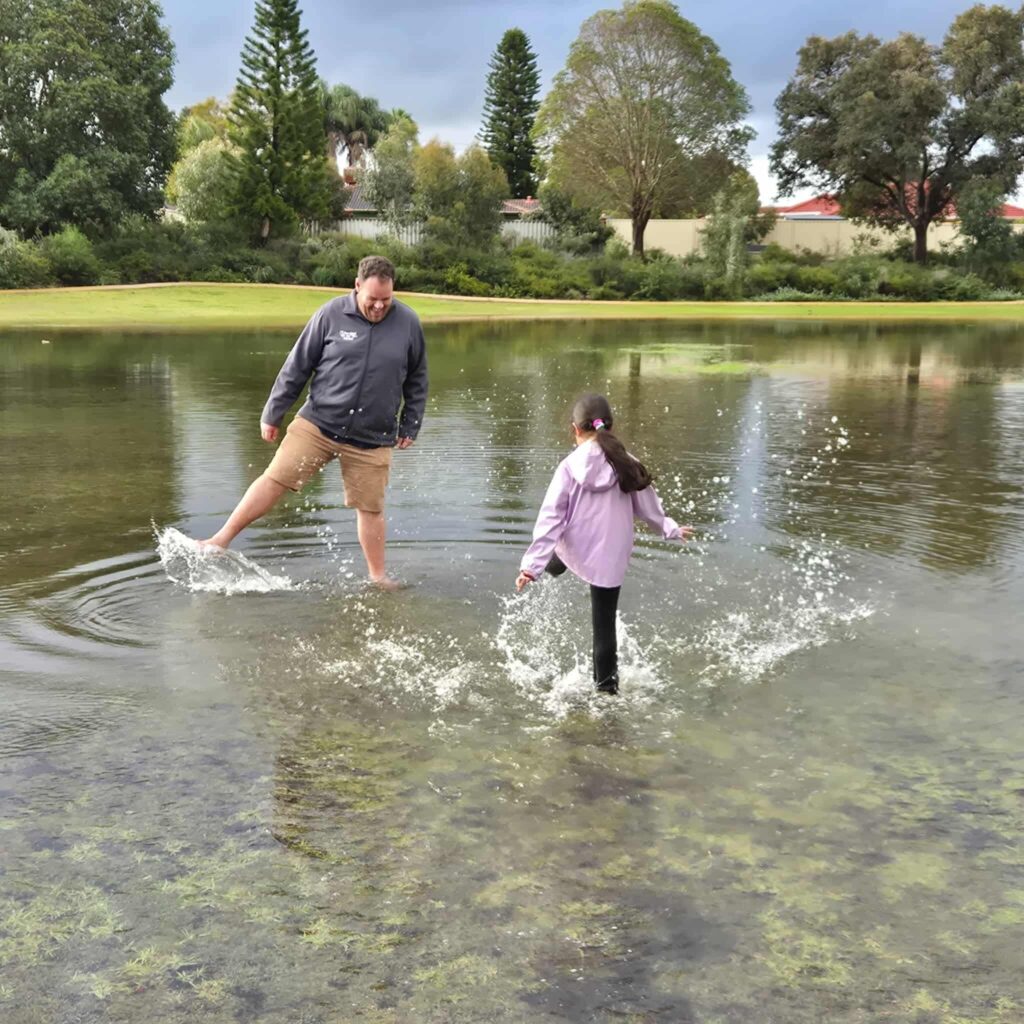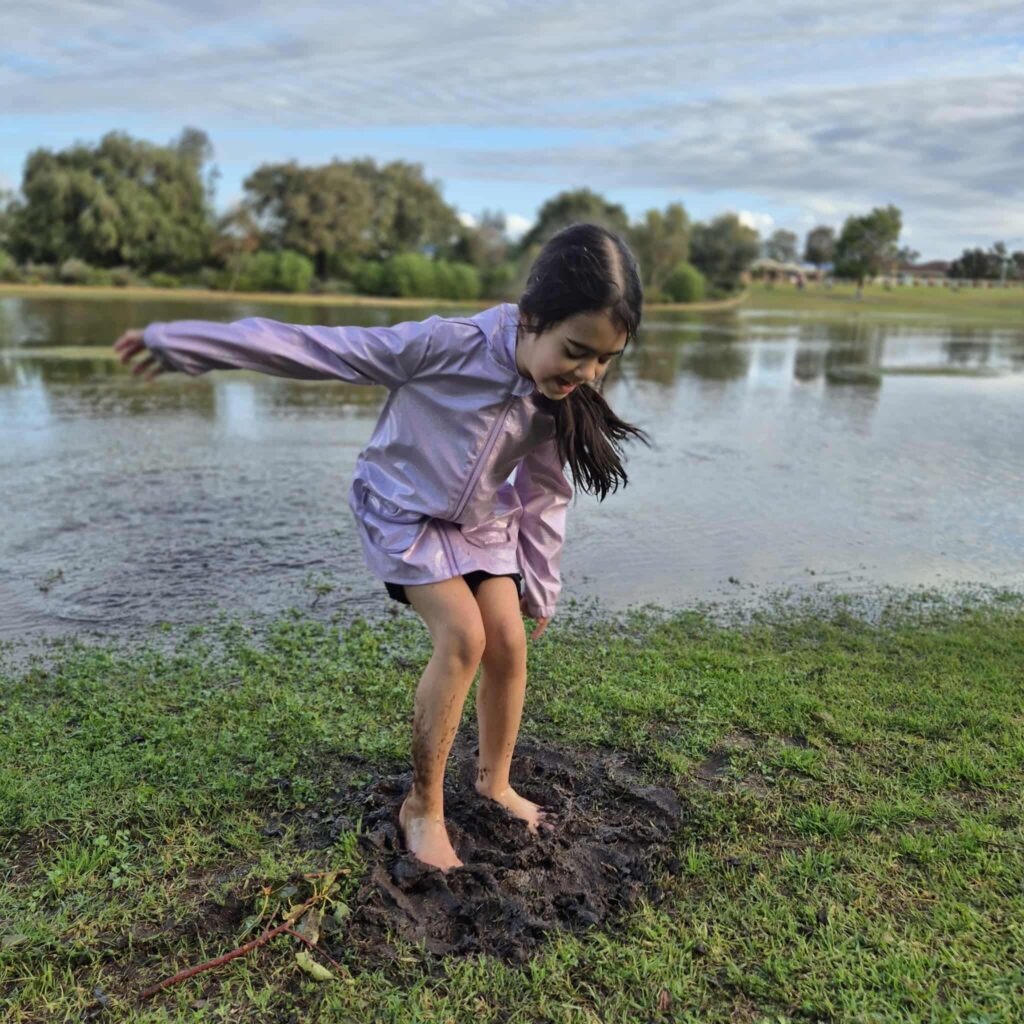A few weekends ago, I spent a glorious afternoon with a young friend in the middle of what can only be described as a giant puddle. Really, it was more like a temporary lake, formed on the local oval after one of the wettest Perth days in years. A natural phenomenon of sorts – one of those invitations from nature that stops you in your tracks and whispers: “Come and play.”
Yet when we arrived, the park was bare. No children. No families. Despite it being a weekend, despite the invitation, there was barely another soul in the space – a few adults walking dogs (who looked confused at our puddle expedition) and a teenager on a bike. It seemed that the wet weather, overcast skies, and clouds were signalling to the local community that it was time to retreat indoors.
But what if nature was instead providing an invitation to step out?
The power of permission
At first, play was hesitant: a tentative walk along the edge, careful steps with gumboots on to keep our feet dry. Luckily, play has a way of inviting us deeper.
First, I took off my shoes. A small gesture, but one that served as permission. Suddenly the whole world opened up. What was once about “not getting too wet” transformed into a celebration of being soaked, splattered, and alive in the moment.
That shift matters. Too often, children pick up on the subtle (and not-so-subtle) messages adults give about staying clean, staying safe, staying inside. Yet the truth is: play thrives when we say yes.
Yes to mud.
Yes to rain.
Yes to getting dirty.
Yes to joy.
Dr. Mariana Brussoni’s work highlights that when adults step back and allow children space, they gain not only joy but also the resilience that comes from navigating challenge and uncertainty.

Discoveries in the puddle
What began as a cautious toe-dip in gumboots quickly unfolded into hours of exploration and delight!
We discovered ants in retreat, scrambling up blades of grass and holding on for dear life as their territory flooded. Listening closely, we noticed the slurpy, sucking sounds of mud beneath our feet, and marvelled at the way it exploded into cloudy swirls when thrown into the water.
Then, we checked our balance (well, as the adult, I did mostly) as we slipped and almost slid on the muddy puddles
We practiced pebble skimming – noticing how the surface of the puddle was both mirror and canvas. Then came the irresistible “risky challenge” of heaving big rocks into the air, waiting for them to crash down with glee, sending fountains of muddy water skyward.
Ellen Sandseter, a researcher of children’s play, reminds us that these “risky challenges” are essential for building confidence and resilience in children. Our afternoon was science, physics, ecology, and pure joy all rolled into one messy adventure.
Where are all the children?
Richard Louv, author of Last Child in the Woods, has long argued that children suffer when we limit their experiences with nature —-a phenomenon he calls “nature-deficit disorder. As we splashed and laughed, I couldn’t shake the emptiness of the oval around us. Where were the other families? Why are our parks so silent after a little rain?
There is a cultural aversion to “bad weather” that means children are missing out on some of the richest, most memorable experiences nature can offer: muddy puddles, slippery logs and stormy skies. These are not inconveniences – they are opportunities for connection, resilience, and wonder.
When we avoid the outdoors on cloudy days, we teach children that nature is only worth engaging with when it’s sunny and dry. We miss the chance to show them that life is not about waiting for the storm to pass, but learning to dance (and splash!) in the rain.

A call to community
Play is not a luxury. It’s a fundamental human need. When communities embrace play – visible, messy, shared – we grow stronger. We build resilience and deepen relationships. The United Nations Convention on the Rights of the Child even recognises play as a basic right -as important as food, shelter, and education.
So, the next time the rain falls, and the puddles gather on your local oval, consider this:
Will you stay inside? Or will you step out, shoes off, and join nature’s invitation to play?
Because sometimes all it takes is a little permission to get muddy. And in that mess, we discover joy.

